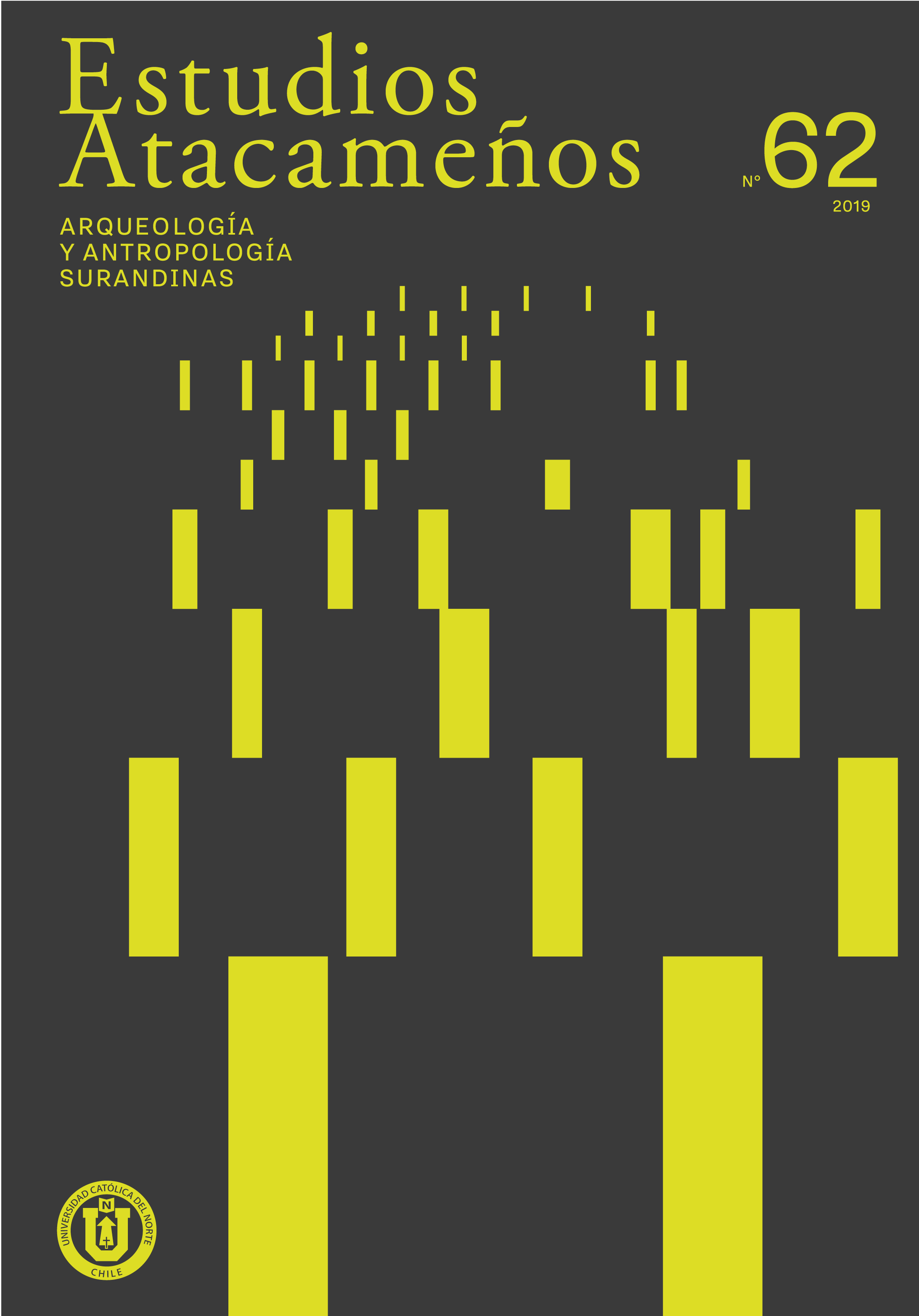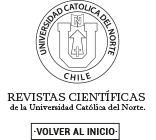Geo graphical representation of the fox in the sky myth
DOI:
https://doi.org/10.22199/issn.0718-1043-2019-0005Keywords:
geoglyphs, fox in the sky myth, condor, discoursive parallelismAbstract
Three sets of geoglyphs present in the Paracas and Nasca desert areas are associated with the Andean myth of the Fox in the Sky. A discoursive parallelism has been identified between the geoglyphs and the myth, establishing the geoglyphs as graphycally rendering scenes of the myth in two cases. In the third case, the characters are present but dispersed.
The myth narrates the trip of the two main characters, the Fox and the Condor to the skies. They are later joined by the Parrot. The result of the mythical actions is the apparition of vegetable species on Earth, especially the oca. These edibles are also delineated on the Nasca Plains.
These geoglyphic sets have been produced, in different styles in the places mentioned, in succesive periods. The myth, found from the Peruvian Central Andes to the Northern areas of Argentina and Chile, is still narrated today.
Downloads
References
Aveni, A. F. (2000). Between The Lines. The Mystery of the Giant Ground Drawings of Ancient Nasca, Peru. Austin: University of Texas Press.
Aveni, A. F. y Silverman, H. (1991). Las Líneas de Nazca: Una nueva síntesis de datos de la Pampa y de los Valles. Revista Andina, 9(2), 367-392.
Barthes, R. (1995). Myth Today. En Tallack, D. (Ed.). Critical Theory: A Reader (pp. 27-42). Londres: Harvester Wheatsheaf.
Benfer, R., Ojeda B., Duncan N., Adkins, L., Ludeña, H., Vallejos, M., Rojas, V. y Ocas, A. (2007). La tradición religioso-astronómica en Buena Vista. Boletín de Arqueología PUCP, 11, 53-102.
Bertonio, Ludovico (1879). Vocabulario de la lengua Aymara, (1612). Edición facsimilar, 2 tomos. Leipzig: Teubner.
Briones, L. y Álvarez, L. (1984). Presentación y valoración de los geoglifos del norte de Chile, en Estudios Atacameños 7, 225-230.
Chirinos, A. y Maque, A. (1996). Eros andino. Cusco: Centro de Estudios Regionales Andinos Bartolomé de Las Casas.
Corominas, J. (1983). Breve diccionario etimológico de la lengua castellana, tercera edición. Madrid: Gredos.
Duch, L. (1998). Mito, interpretación y cultura. Barcelona: Herder.
Eliade, M. (1965). Le sacré et le profane. Paris: Editions Gallimard.
Espinoza, G. (1998). Lari y Jamp’atu. Ritual de lluvia y simbolismo andino de una escena del arte rupestre de Aruquilda 1. Norte de Chile. Chungara, 28(1 y 2), 133-157.
Estudio Casabonne (2017). Fotos geoglifos de Nazca. Lima.
García, R. (2013). Geoglifos Paracas de la costa sur: cerro Lechuza y cerro Pico. Boletín de Arqueología PUCP, 17, 151-168.
Gilli, B 1200px-Milky_Way_Arch By Bruno Gilli ESO http www.eso.org public images milkyway CC BY 4.0
González, D. (1989 [1608]). Vocabulario de la lengua Qquichua o del Ynga. Francisco del Canto, Lima, tercera edición facsimilar. Lima: Universidad Nacional Mayor de San Marcos.
Isla, J. (2017). Los geoglifos de Palpa y Nazca en “Uno a Uno”, Conferencia en el MALI en el marco de la muestra Nasca, 14 septiembre 2017.
Itier, C. (1997). El zorro del cielo: un mito sobre el origen de las plantas cultivadas y los intercambios con el mundo sobrenatural. Bulletin d’Etudes Andines, 26(3), 307-346.
Lambers, K. (2017). Los geoglifos: imágenes y escenarios en el desierto de Nazca y Palpa. En Nasca, Asociación Museo de Arte de Lima, Lima.
Linares, E. (2004). Arte rupestre en Arequipa y el sur del Perú. Arequipa: Nuevo Milenio.
Nasca Exposición. Curaduría: Cecilia Pardo (MALI) y Peter Fux (Museo Rietberg) 21 junio–15 octubre 2017. http://www.mali.pe/expo_detalle.php?id=146. Consultado: octubre 2017.
Ondegardo, P. (1906 [1585]). Los errores y superstiçiones de los indios sacadas del Tratado y averiguaçion que hizo el Licenciado Polo. Revista histórica, I(1), 207-231.
Pardo, C. y Fux, P. (Eds.). (2017). Nasca. Lima: Asociación Museo de Arte de Lima.
Perú Ecológico (2012). http://www.peruecologico.com.pe/. Consultado: junio 2016.
Pitluga, P. (1992). An Astronomical Model for the Nazca Figures. En American Astronomical Society, 23rd. DDA/HAD Meeting, p.1067.
Pucher de Kroll, L. (1950). El auquénido y la cosmogonía amerasiana. Potosí: Universidad Tomás Frías.
Real Academia Española de la Lengua (2001a y b). http://www.rae.es/. Consultado: septiembre 2016.
Reindel, M. e Isla, J. (2006). Evidencias de culturas tempranas en los valles de Palpa, costa sur del Perú. Boletín de Arqueología PUCP, 10, 237-283.
Reindel, M., J. Isla y K. Lambers. (2006). Los geoglifos de Palpa: Documentación, análisis y perspectivas. Boletín de Lima, 143, 73-111.
Rocha, A. (2010). Paracas. Figuras en el desierto. SOMOS 1209, 30-38. En Diario El Comercio, Lima 6 febrero 2010.
Rodríguez, A. (1997). Los campos de geoglifos en la costa central del Perú. Cuadernos de investigación, 2. Instituto Riva Agüero, Pontificia Universidad Católica del Perú.
Rosales, J. (2014). Fuertes vientos dejan a la vista nuevos geoglifos en Nasca. En Diario El Comercio, Lima, 2 agosto 2014, http://elcomercio.pe/peru/ica/ (Consultado: septiembre 2017).
Salazar, E. (2014). Astronomía Inka. Arqueoastronomía & Etnoastronomía, Lima: Museo Andrés del Castillo, Colección Enigmas del Antiguo Perú.
Spalding, K. (1984) Huarochirí. An Andean Society Under Inca and Spanish Rule. Stanford: Stanford University Press.
Taylor, G. (1987 [1598-1608]). Ritos y tradiciones de Huarochiri del siglo XVII, Manuscrito quechua de comienzos del siglo XVII. Versión paleográfica, interpretación fonológica y traducción del autor. Lima: Instituto de Estudios Peruanos e Instituto Francés de Estudios Andinos.
Urton, G. (1978). Beasts and Geometry: Some Constellations of the Peruvian Quechuas. Anthropos, International Review of Ethnology and Linguistics, 73, 32-40.
Urton, G. (1981). At the crossroads of the earth and the sky: an Andean cosmology. Austin: University of Texas Press.
Van Kessel, J. (1993). El tramposo engañado: el zorro en la cosmovisión andina. Revista Ciencias Sociales, 3, 37-52.
Varón, R. (1990). El Taki Onqoy: las raíces andinas de un fenómeno colonial. En Millones, L. (Comp.). El retorno de las huacas. Lima: Instituto de Estudios Peruanos, Sociedad Peruana de Psicoanálisis, 331-405.
Zorro andino (2007). https://animalesyplantasdeperu.blogspot.pe/2007/04/el-zorro-andino.html. Consultado: diciembre 2015.
Zorropedia. (2012). http://www.zorropedia.com/ Consultado: agosto 2016.
Zumthor, P. (1994). La medida del mundo. Representación del espacio en la Edad Media. Alicia Martorell (Trad.). Madrid: Ediciones Cátedra.
Downloads
Published
Issue
Section
License

All works published in Revista Estudios Atacameños (ISSN on line:0718-1043) Revista Estudios Atacameños Creative Commons International 4.0 attribution (CC BY 4.0) licence.
Authors remain the owners of their work and may republish their articles elsewhere without having to request permission, as long as they indicate that the work was originally published in Revista Estudios Atacameños (ISSN on liine:0718-1043).












